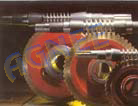 ISO 9001:2008 Enterprise |
|
Special Focus |
| In the News News Index  Agnee Registered as Vendor with Defense Details |
| Agro Engineers (ISO 9001:2008 Enterprise) F-557, Indraprastha Industrial Area, Kota - 324005, Rajasthan, INDIA. Telephone:+91-744-2490773 Contact Us |
 D&B D-U-N-S® Number |
Home | About Us | Contact Us | Complaint | Warranty
|
|
|
|||||||||||||||||||||||||||||||||||||||||||||||||||||||||||||||||||||||||
Worm Gear |
||||||||||||||||||||||||||||||||||||||||||||||||||||||||||||||||||||||||||
| ||||||||||||||||||||||||||||||||||||||||||||||||||||||||||||||||||||||||||
|
Features:- The efficiency of worm gear depends on the lead angle, sliding speed, and lubricant, surface quality and installation conditions. They offer smoothest, quietest form of gearing. They provide high-ratio speed reduction in minimal spaces. Worm gears are used when large gear reductions are required. Worm gear has a unique property of easily turning the gear. The gear cannot turn the worm because the angle on the worm is shallow and when the gear tries to spin the worm, the friction between the two holds the worm in place. Worm gears work under difficult conditions, presenting unique lubrication demands. The types of oils most commonly used to lubricate worm gears are compounded mineral oils, EP mineral gear oils and synthetics. Worm gear is always used as the input gear. For the operation of worm gear, torque is applied to the input end of the worm shaft by a driven sprocket or electric motor. The worm and the worm shaft are supported by anti-friction roller bearings. Because of high friction worm gears are very inefficient. There is lot of friction between a worm gear and the gear being driven by the worm gear. When used in high torque applications, the friction causes the wear on the gear teeth and erosion of restraining surface. |
||||||||||||||||||||||||||||||||||||||||||||||||||||||||||||||||||||||||||
| Worm Gear-Basic
Dimensions
Gear dimensions are
important because they provide valuable information when
determining how best to meet a customer’s needs. Here are
definitions we need to know in order to determine the basic
dimensions of worm gears. |
||||||||||||||||||||||||||||||||||||||||||||||||||||||||||||||||||||||||||
| Worm Gear-Tooth Dimensions | ||||||||||||||||||||||||||||||||||||||||||||||||||||||||||||||||||||||||||
|
|
||||||||||||||||||||||||||||||||||||||||||||||||||||||||||||||||||||||||||
|
1. Addendum – The distance from the pitch circle to the
throat circle. |
||||||||||||||||||||||||||||||||||||||||||||||||||||||||||||||||||||||||||
| Worm and Worm Gear Formulas | ||||||||||||||||||||||||||||||||||||||||||||||||||||||||||||||||||||||||||
|
||||||||||||||||||||||||||||||||||||||||||||||||||||||||||||||||||||||||||
| Application Worm gears are a compact, efficient means of substantially decreasing speed and increasing torque. Worm-drives have also been used in a few automotive differentials. The worm-wheel carries the differential gearing. This protects the vehicle against rollback. This has largely fallen from favour due to the higher than necessary reduction ratios. Worm gears are widely used in packaging machinery, material handling, machine tools, indexing and food processing. They are used widely in conveyor systems. They are also used in torsen differential, used on some high-performance cars and trucks. They serve as speed reducers in many different industries. |
||||||||||||||||||||||||||||||||||||||||||||||||||||||||||||||||||||||||||
|
|
<<back |
|
||||||||||||||||||||||||||||||||||||||||||||||||||||||||||||||||||||||||


